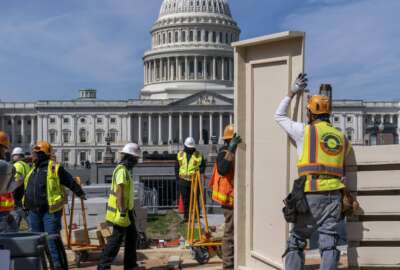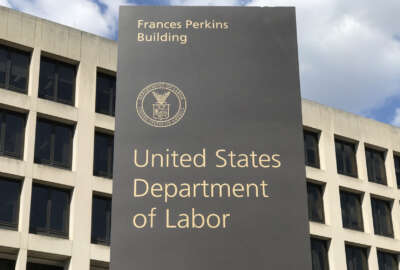
Contractors take issue with gigantic new rule from the Labor Department
The Labor Department is out with a final rule to update how the government determines wages it will allow in federal construction contractors, as well as in...
The Labor Department is out with a final rule to update how the government determines wages it will allow in federal construction contractors, as well as in federally assisted construction. The new rule is 812 pages long. It’s not sitting well with the construction industry. For one reaction, Federal Drive with Tom Temin spoke with Claiborne Guy, from the trade group Associated General Contractors of America.
Interview Transcript:
Tom Temin And you have looked at this rule. I guess it takes a long time to digest 812 pages of rulemaking. But this basically is to update how wages are determined under the Davis-Bacon Act dating back to the 1930s.
Claiborne Guy Correct. This prevailing wages you have to provide them on federal construction contracts or federally assisted construction projects, and they have not. This is most comprehensive update that they’ve done since the eighties. And the main crux of it is updating how they determine what is truly called a prevailing and prevailing wage rate. Previously, they went by a 50% threshold to where they’d gather data on wage rates in certain areas. And if it crossed the 50% threshold that that was considered prevailing. Now they’ve lowered it to actually, though, this is an update. They’re going back to pre 1983 rule to where the threshold was 30%.
Tom Temin Interesting. So they’re going to the pre Reagan era, you might say.
Claiborne Guy Correct.
Tom Temin Before we get to some of the details. Who determines that the wages is it the contractors in bidding or is it the government that does the determination and tells you what they are and then you bid on a contract? How does that all work in practice?
Claiborne Guy The Department of Labor goes out and does a voluntary survey process to where they try to get construction contractors to submit what they pay. In county, certain counties, it’s typically county by county. And then what they do is they take that back, figures it crosses the threshold to what is prevailing and then they publish it. And so, again, county by county works, where the work done is the wage rates are set by the DOL, and then the procurement agencies are supposed to have those in the bid documents and actually the final contracts as well. So the contractors, one can set the proper bids with the assumed labor costs and then in the end pay the proper wages.
Tom Temin So you need that information to make the bid. And that in theory puts everybody on the same footing then that would bid in terms of what they’re going to pay labor for that contract.
Claiborne Guy Yes, in theory, but many times those wage rates are severely out of date as well as incorrect or missing. So there’s still a lot of ambiguity out there when contractors are going through the bidding process.
Tom Temin And what’s the practical effect of 30% of the wages being paid in an area versus 50%? Because I mean, I’ll just put it out there. This administration is trying to favor union labor in word and deed pretty much every time they mention something. And so is this to make sure that union construction wages get followed in more places than they do now? Do you think?
Claiborne Guy Yes. In essence, it is going to make it easier for them to use collective bargaining agreement rates to set the wage rates, because, again, it’s a voluntary survey process, but the unions are more organized. And so they have all their wage rates right there in the CBA. They could split the CBA and therefore it’s easy for the DOL to just pick those rates.
Tom Temin And if that’s the situation, then what can contractors compete on? If everyone’s paying the same wages and it takes the same amount of labor to erect a steel structure that’s 12 stories by a block or something, whatever. How do you compete? What other cost elements can you compete on?
Claiborne Guy Correct. It’s difficult to compete when you can’t really reduce material prices. So also that on top of it, we’ve got a historic labor kind of crisis right now. So it’s hard to even pay those rates currently.
Tom Temin Just to find the people. In other words.
Claiborne Guy Mm hmm. Correct.
Tom Temin And I look at the cranes all over the Washington, D.C. area and in Northern Virginia, I imagine there’s lots of cranes. In fact, sometimes in New York, they topple over what is construction labor per hour generally now in high cost areas where there is a high concentration of union labor.
Claiborne Guy It’s extremely high. I’d have to go back to the BLS data that has it out there. But I think like the average is way above minimum wage rates, etc., and even CBAs. There’s a crisis, a workforce crisis. Contractors can’t keep up. They can’t get people into the industry. So they’re just the only way they can attack it is with higher wage rates.
Tom Temin Right. And it is difficult work outside manual strength required. I mean, it’s not exactly office work.
Claiborne Guy No, you got to incentivize them to do that kind of work.
Tom Temin Sure. We’re speaking with Claiborne Guy. He is director of employment policy and practices at the Associated General Contractors of America. And tell us about the rulemaking. Did you weigh in on it? Did you comment and so forth? And what’s the process next? Because it hasn’t officially been published.
Claiborne Guy As you mentioned, it’s a massive rule. It’s close to 800 pages. It’s the most comprehensive update that the DOL has done in 40 years. They went out with a proposal first. Actually, they went out for industry and public input prior to the proposed rulemaking, which we participated heavily in. We worked with wage and hour to submit suggestions. And then when the proposed rule came out, we submitted a extensive comment letter with our thoughts are very deep thoughts on what should be in Davis-Bacon reform, because we’ve been looking at this for decades now. They came out with the final rule. It was not officially published. So that’s when it becomes real. Instead, the DOL released the rule and then the vice president made the announcement last week about it, and they plan to publish it on the 23rd. Once that is published, it will have a 60 day effective rate. So that means that I think it’s October 23rd is when contractors will have to be fully up to speed and ready to comply with all the new changes and wrinkles in it, as well as procurement agencies that are going to need to be ready to put this in the contracts and kind of help guide contractors along, especially during the bidding process and let the projects go into effect. Again, this is just for new contracts, new projects, new or renewed projects. But again, that 60 day date is looming.
Tom Temin And in the industry, do the large contractors, the national contractors, the names you see on all these cranes and see the same names and city after city? Do they tend to be more unionized than small contractors or, say, disadvantaged minority owned contractors?
Claiborne Guy Yes, because they do projects all over the country. So if you think about it, they do work in union and nonunion areas. They have the resources to do that.
Tom Temin Right. So they could be union in one city. But if they’re doing something out in the hinterlands, say, building a data center or something, that could be nonunion construction, labor.
Claiborne Guy Yes.
Tom Temin And the small companies, do they tend to be unionized by location or do they tend to just not be as unionized in general as the large guys?
Claiborne Guy I’d say they tend to be, again, location by location, but yes, I’d say they tend to be less unionized, the smaller ones.
Tom Temin And do you feel this rule or do you predict that this rule extends the geographical footprint of where contractors would need to use union labor?
Claiborne Guy Yes. Yes. Because especially it reduces it to the 30% threshold for setting the prevailing wage as more than likely going to lean on CBAs. Collective bargaining agreements to set those hidden rates, especially in the rural areas, because that’s where they have a really hard time setting prevailing wages because of lack of participation in the surveys.
Tom Temin Right. So I guess what I’m getting at is could this favor the large contracting firms over the small ones in terms of winning contracts, do you think?
Claiborne Guy Yes. Yes. And there’s also another wrinkle in it, too, where in the rural areas to where they have a difficulty setting the rates, the DOL in this rule is giving themselves permission to use urban rates when they don’t have enough data. So obviously, when you think about that, these urban rates of rural areas is going to favor the larger contractors that can bring their workers in from those urban areas.
Tom Temin So if a state then can convince the government to fund a bridge under the infrastructure bill, for example, that is somewhere out in the country that’s covering a river gorge. And that bridge was first put in the 1930 and it’s time to replace it. There’s lots of bridges like that. There is no city nearby. Then there’s no prevailing wage. If if that’s the only construction project in a 40 mile radius, I’m making these numbers up. But then if a city is 60 miles away or a hundred miles away, it could be that that’s the prevailing wage that would apply to that remote bridge.
Claiborne Guy Yes, that’s what the Department of Labor is giving themselves the ability to do. And as you can see, it could impact the ability to bring people in. They’d have to bring them in from those urban areas and affect the local workers, the local supply.
Tom Temin Right. So if you could find local workers, then that would be good for them.
Claiborne Guy Sure. If you could. But that’s the difficulty we’re having right now, is finding the workers and they tend to go to where the work is.
Tom Temin Right. So if the work is in the cities, then what do contractors do out in the country? Do they bring people in and house them or what? How does that work?
Claiborne Guy They typically bring them in and they don’t specifically house them. They usually use per diem to kind of pay for their housing in kind of it’s also utilization to get them to those areas. Again, this is what we’re tackling the workforce shortage with more and more money.
Copyright © 2024 Federal News Network. All rights reserved. This website is not intended for users located within the European Economic Area.
Tom Temin is host of the Federal Drive and has been providing insight on federal technology and management issues for more than 30 years.
Follow @tteminWFED





